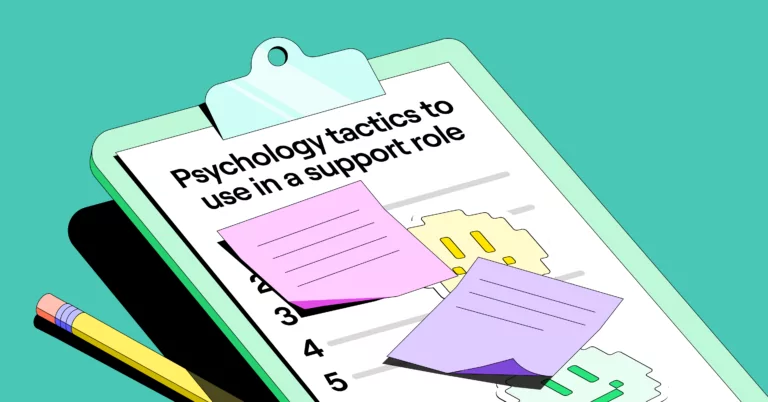Leading a customer-facing team has its fair share of celebratory moments.
But some days, it can feel like you’re a human punching bag. Whether you’re falling short of target satisfaction scores, fielding escalated complaints, or feeling like you’re not doing enough for your reps –– 59% of whom are reportedly at risk of burnout –– delivering stand-out customer support is not for the faint of heart.
If you’re looking for a lifeline, behavioral and positive psychology-inspired tactics could be the assist your team needs.
The focal points of positive psychology are building positive relationships with and cultivating the strengths of those in your sphere. These tactics can create desirable results for customer experience teams, including:
- Empowered reps: Feeling supported and motivated at work go hand in hand. Reps who are part of a positive work culture are often more efficient, more confident in handling difficult situations (rather than needing to escalate them), and more likely to stay in their jobs.
- Reduced customer churn: Empowered reps create more positive interactions with customers; they make customers feel like much more than a dollar sign. And that keeps people coming back for more: 62% of customers say they feel emotionally connected to the brands they buy from repeatedly.
- Increased word-of-mouth referrals: Everyone knows people start to talk when they’ve had a great experience –– or a terrible one. In fact, great customer service alone has prompted 82% of customers to recommend a business to a friend.
Whether it’s being empathetic or practicing active listening, the tactics outlined here might sound simple and obvious at first glance. But they’re proven to upgrade how customers perceive their experience.
And, as they say, perception is reality.
Tactic #1: Be empathetic
Empathy, or the ability to understand and share another person’s feelings, is a superpower in customer service. It helps reps form personal connections with customers and, in turn, fosters feelings of trust.
When a situation goes sideways, a foundation of trust may make it easier to restore your customer relationship.
Let’s say you ordered a birthday gift for a friend well ahead of their birthday party. But something went wrong, and the gift was lost because of the delivery service.
If you reach out to a customer service rep to complain and the rep doesn’t quickly validate your frustration, you may be even more irritated than when you started.
“As part of the customer experience, you want to put yourself in the customer’s shoes and understand the customer’s needs,” says Justina Altiere, Vice President of Customer Experience at OpenPhone.
Justina adds that displaying toxic positivity rather than empathizing with a customer’s pain can come off as dismissive and, ultimately, harm the relationship.
Take it a step further with empathy. For example, during the COVID-19 pandemic, Nike waived their app subscription fee for at-home exercise videos to show they understood how disappointed many customers were to have their lives put on hold.
3 practical ways to show empathy
Encourage your team to demonstrate empathy with statements like:
- “It’s totally reasonable for you to be upset. And this isn’t the way we want to serve you.”
- “I’d be just as frustrated if I were in your shoes.”
- “I know you’re upset about this situation –– and you have every right to be.”
Tactic #2: Listen actively
In addition to being empathetic, listening to and ensuring you fully understand a customer’s issue is crucial to providing good customer service. As basic as it might sound, listening to people is an often-overlooked skill.
Customer support reps often sift through high volumes of tickets –– many of which may seem like the same issue. If a rep skims the tickets and then sends templated responses to all these customers, they may fail to fully grasp the details of each person’s issue. The result? A lot of irritated people coming back to them with the same response: “You didn’t pay attention to what I said.”
“You want to actively listen and ask the right qualifying questions so you can anticipate what other needs the customer may have that are tangential to why they are reaching out,” Justina says. “Don’t just use a templated response after reading a query quickly; take your time to respond in a way that really addresses what the customer is reaching out about.”
Of course, templated responses have their time and place –– and they’re a helpful, necessary part of operating any customer service team at scale. And practicing active listening with every customer ensures you don’t lose your human touch.
3 practical ways to listen actively
Encourage your team to practice active listening by asking open-ended questions like:
- “What were you doing when this issue popped up?”
- “How would you describe your ideal resolution to this problem?”
- “How is this issue impacting your team and business?”
Tactic #3: Offer relevant apologies and reassurance
Directly apologizing for any pain a customer is experiencing –– and taking ownership for negative experiences –– is critical.
Remember when Southwest Airlines canceled more than 16,000 flights during the 2022 holiday season? The debacle impacted more than 2 million customers, and Southwest ultimately issued a public apology. They then covered various travel expenses for affected customers and gave out frequent-flyer miles.
The quality of a company’s apology and repayment will always be debated in the court of public opinion. But where there is customer pain, there should be an apology –– and some confirmation this isn’t the intended customer experience.
“You want to feel the customer’s pain and apologize on behalf of the company,” Justina says. “You also want to reassure the customer they made the right choice when investing in your product or service. If they hit a speed bump, like a bug, you are going to make sure that it’s escalated internally to be fixed.”
That said, Justina also warns about taking things too far: Apologize, but don’t over-apologize, she says. Over-apologizing can make your business seem weak and chip away at customers’ confidence in you.
Instead, explain why their issue happened and reassure them the appropriate team is working to resolve their problem. Then, make sure you follow through.
3 practical ways to apologize and offer reassurance
Encourage your team to apologize with confidence by saying things like:
- “We’re so sorry you’re experiencing this. This isn’t part of our normal product offering, and it isn’t the experience we want you to have.”
- “Our [specific team] is working on this issue. I’m so sorry you came across this.”
- “This shouldn’t have happened, and I’m sorry you experienced this. Let me show you the customer experience we intended to give you in the first place.”
Tactic #4: End on a high note
Humans naturally find the ending to be the most memorable part of any experience.
So if you end a customer interaction with a little bit of attitude, that’s what they’ll remember –– even if the rest of the experience was decent.
Ending customer interactions on a high note increases the chances their lasting impression of your company will be a good one.
It doesn’t take much: personalize the experience by using the customer’s name, offer the customer a discount on their next purchase, or share some lesser-known tips with them on how to get the most out of your product or service.
You can even bounce back from less-than-ideal things that happened at the beginning of the interaction –– like a long hold time or being transferred to another rep –– by orchestrating a positive ending.
Think of the check-out experience at most hotels. Most of the time, all you have to do at the end of your stay is drop your room key in a box. It’s an insignificant yet seamless part of your time at the hotel. A pleasant ending makes it easier to recall that free breakfast or room upgrade versus a slow check-out line at the reservation desk.
3 practical ways to end a customer interaction on a high note
Encourage your team to sign off with customers on good terms by saying things like:
- “Thank you again for your business, [customer name]. It’s been a pleasure assisting you today.”
- “We appreciate your repeat purchases with us. As a thank you, I’d like to offer you a 10% discount coupon to use next time.”
- “Thank you for your purchase today. Let me send you the link to our library of video tutorials so you can reference them whenever you need to.”
Tactic #5: Give a sense of control
Most people naturally want to feel a sense of agency –– like they have some say in how things will go.
So it makes sense that customers are more satisfied with a business when they feel like they have control over their experience.
Fortunately, that perception of control can be engineered by offering customers choices at every turn: Provide self-serve options, opportunities to message or call for more information, and the chance to indicate a preferred call-back time. Help your customers feel like they’re in the driver’s seat.
Consider this scenario: Small business owners often rely on their phone service to communicate with customers, and any interruption in that service can be stressful. So, for them, porting a number doesn’t exactly inspire calm and relaxation.
But OpenPhone customers have access to an online portal where they can track the status of their number-porting application and see expected wait times, all of which gives them a sense of control and peace of mind throughout the process.
3 practical ways to help customers feel like they’re in control
Encourage your team to put customers in the driver’s seat by saying things like:
- “Do you mind if I place you on a brief hold?” (and wait for the customer to answer)
- “I need to check with a teammate to get the necessary information for your case. When would be a good time for me to call you back?”
- “You do get a discount if you pay for the year upfront, but it’s totally up to you if you’d rather pay month-to-month.”
Bonus tactic: Become an OpenPhone customer
Acknowledging and harnessing the power of behavioral and positive psychology can truly kick your customer service up a notch.
When practiced together, demonstrating empathy, listening actively, offering sincere apologies, orchestrating positive endings, and providing your customers with a sense of control, can help them feel seen, heard, and cared for. It’s about keeping a sense of humanity at the heart of your entire customer experience.
Embracing modern business communication tech tools can make implementing these tactics a little easier.
OpenPhone’s collaborative internal workspaces, call recording capabilities, and lightweight CRM experience are designed to improve all your customer communication.
Find out how OpenPhone can help you up your customer support game. Start your free seven-day trial today.

